There were 5 posts tagged: Lync
How to choose between a Microsoft Certified and UC device
As you are shopping the Avcomm Solutions web site, you may notice that many of our products such as USB headsets and speakerphones, are labeled as "Microsoft," "MS," or "Certified for Microsoft," while others are labeled "UC." We are often asked the difference between a Microsoft and UC (Unified Communications) product, and how to choose between them.
Our answer: If you are using a Microsoft platform (such as Microsoft Teams, Skype for Business, or Lync), you should purchase the Microsoft certified variant.
What this means: the models certified for Microsoft support Microsoft platforms as a Plug and Play experience. The Plug and Play experience includes:
•automatic selection as the default audio device and
•features to answer and end calls, adjust volume, and mute.
If you are using another communications platform, such as Cisco Jabber, Ring Central, or other softphone, you should purchase the standard UC version of the headset or speakerphone. If you do use a model that is certified for Microsoft Skype for Business with a different computer softphone client, the product should work the same as a UC model regarding audio and features (such as answer and end calls, adjust volume, mute).
To set up your headset or speakerphone to work with Microsoft Skype for Business (or Teams, or Lync), install the headset manufacturer's free software:
Jabra Direct for Jabra products;
Hub Desktop for Plantronics, now Poly, products or Poly Lens App for newer Poly devices;
and EPOS Connect (formerly Sennheiser HeadSetup Pro) for EPOS | Sennheiser products.
All of these are free from the manufacturers.
For further help with your unique headset and speakerphone needs, reach out to our dedicated customer care team at 1-866-998-9991, via email, or Chat with us now.
Our answer: If you are using a Microsoft platform (such as Microsoft Teams, Skype for Business, or Lync), you should purchase the Microsoft certified variant.
What this means: the models certified for Microsoft support Microsoft platforms as a Plug and Play experience. The Plug and Play experience includes:
•automatic selection as the default audio device and
•features to answer and end calls, adjust volume, and mute.
If you are using another communications platform, such as Cisco Jabber, Ring Central, or other softphone, you should purchase the standard UC version of the headset or speakerphone. If you do use a model that is certified for Microsoft Skype for Business with a different computer softphone client, the product should work the same as a UC model regarding audio and features (such as answer and end calls, adjust volume, mute).
To set up your headset or speakerphone to work with Microsoft Skype for Business (or Teams, or Lync), install the headset manufacturer's free software:
Jabra Direct for Jabra products;
Hub Desktop for Plantronics, now Poly, products or Poly Lens App for newer Poly devices;
and EPOS Connect (formerly Sennheiser HeadSetup Pro) for EPOS | Sennheiser products.
All of these are free from the manufacturers.
For further help with your unique headset and speakerphone needs, reach out to our dedicated customer care team at 1-866-998-9991, via email, or Chat with us now.

Kuando Busylight Software Updated
A steady uptick in headset use, and the rise of unified communications platforms such as Skype for Business, Lync, Cisco Jabber, (and many more), have contributed to the need for Busylights in office environments around the world, especially in the prevalent open office design.
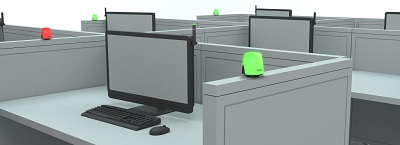 The Kuando Busylight is a 3-in-1 solution:
The Kuando Busylight is a 3-in-1 solution:
Download the FREE software on the Plenom website: Software Download. Plenom is currently at work on a NEW Busylight for Apple Mac computers. We will let you know when these are available!
 The Kuando Busylight is a 3-in-1 solution:
The Kuando Busylight is a 3-in-1 solution:- It rings and flashes on incoming calls preventing missed calls.
- It provides visual presence to the open office, stopping interruptions.
- The Busylight software (Skype for Business only) provides valuable hot key functions for easy call handling.
- Mute on Away – When in the ‘Away’ state, Busylight will not ring – nice for your neighbor!
- Brightness Setting – Easily control the brightness of your Busylight
- Default volume for Omega will now be set at 25%
- Default brightness for Alpha is lowered from high to normal.
Download the FREE software on the Plenom website: Software Download. Plenom is currently at work on a NEW Busylight for Apple Mac computers. We will let you know when these are available!
Kuando Busylight: an Easy-to-Use Solution for Presence Notification
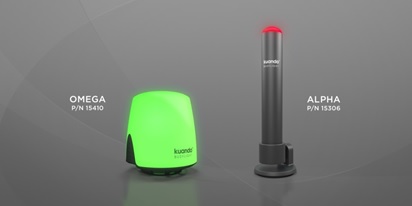
The concept of presence notification is not new – Mitch Friend of Plenom reports that he has heard of workers using red and green flags or even red and green Solo cups to alert co-workers of their availability; however, with the Kuando Busylight, user presence is automatically updated and is always reliable.
The Kuando Busylight from Plenom provides 3 main functions:
- It rings and flashes on incoming calls, preventing missed calls.
- The free Busylight software provides hot key functions for call handling.
- It provides visible presence in the open office, preventing interruptions.

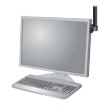 Plenom offers two Kuando Busylight designs: the Alpha (MSRP $44.95) can be attached to a desktop monitor or laptop with the included double sided tape. A magnet, also included, can be used to attach the Alpha to the top of a metal cubicle wall.
Plenom offers two Kuando Busylight designs: the Alpha (MSRP $44.95) can be attached to a desktop monitor or laptop with the included double sided tape. A magnet, also included, can be used to attach the Alpha to the top of a metal cubicle wall.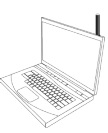
The Omega (MSRP $44.95) is ideal for a cubicle arrangement, as it has a larger light. It attaches to the top of the cubicle with double-sided tape.
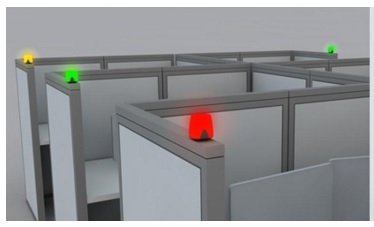
Download Plenom’s free software when you’re ready to set up the device: Plenom Software. This software is used with both Kuando Busylights, as well as the KuandoBOX.
Kuando Busylight supports the colors of Skype for Business/Lync:
Red: On a Call; Do Not Disturb
Pulsing Red: Busy in a call
Blue, Purple or Pink: Do Not Disturb
Green: Available
Yellow: Away/Inactive
There are 8 different ringtones to choose from, including traditional telephone sounds and a dreamy melody called “Fairy Tale.” These sounds are built into the Kuando Busylight so there is no conflict with the PC’s sound settings.
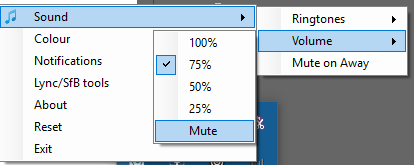
And, it is easy to quickly adjust the volume of the ringtone. Click on the Busylight icon on your desktop and the menu will pop up (see image to the left). Choose your preferred volume level, or choose Mute to silence the ringer altogether.
Kuando Busylights are currently compatible with Microsoft Lync/Skype for Business and will soon be compatible with Cisco Jabber (March release). System requirements for Kuando Busylight: Windows XP SP3, Windows Vista, Windows 7 or Windows 8; Microsoft Lync 2010/2013 or Skype for Business; .NET 3.5 framework. Kuando Busylight is not compatible with Mac.
The modern workplace can be a very social environment, a positive place for collaborating on projects and supporting comaraderie; however, studies show there is a loss of productivity in open offices that can result in employee frustration and stress. The chance for uninterrupted work time is greatly reduced when barriers such as walls and doors are removed. With the proliferation of Microsoft Lync/Skype for Business, as well as the pervasive open office environment, workers are exposed to interruption and missed calls. Plenom has provided the perfect solution with the Busylights: Alpha and Omega. A one-year warranty gives you peace of mind.
If your staff has complained that they can’t focus on their work; they don’t hear calls or IM notifications on Skype for Business/Lync, then Kuando Busylight is the right solution for you. Give us a call and we can choose the best Busylight for your office environment!
New Jabra Stealth UC Bluetooth Headset Enhanced by Free Apps
The Jabra Stealth UC headset weighs no more than a quarter, is shorter than a standard toothpick, yet delivers powerful technology. If you’re looking for a small, lightweight and discreet Bluetooth headset that fits directly into your ear, the Jabra Stealth UC fits the bill. As a Red Dot Design Award 2015 winner, the product’s design has been given the “cool” stamp of approval.
 The Stealth headset has been available for about a year; the addition of the USB dongle has made the headset feasible for the UC market. Those who work with their PC and smartphone will enjoy the ability to use either device with this headset. Available in both UC and Microsoft Lync-optimized versions, the Stealth UC is compatible with any major softphone on the market.
The Stealth headset has been available for about a year; the addition of the USB dongle has made the headset feasible for the UC market. Those who work with their PC and smartphone will enjoy the ability to use either device with this headset. Available in both UC and Microsoft Lync-optimized versions, the Stealth UC is compatible with any major softphone on the market.
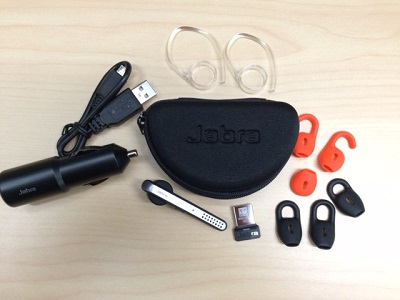 A microPOWER battery (typically found in hearing aids) makes this the lightest-weight Bluetooth headset on the market – a mere 0.28 ounce! The small design provides a comfortable in-ear fit for wearing in either the left or right ear. To customize the fit, two sets (3 red and 3 black) of comfort ear gels of various sizes are included (see image). Users who prefer an ear hook wearing style have 2 different sizes of ear hook to choose from, which are also included in the box. The Stealth will stay in the ear, so an ear hook is not necessary.
A microPOWER battery (typically found in hearing aids) makes this the lightest-weight Bluetooth headset on the market – a mere 0.28 ounce! The small design provides a comfortable in-ear fit for wearing in either the left or right ear. To customize the fit, two sets (3 red and 3 black) of comfort ear gels of various sizes are included (see image). Users who prefer an ear hook wearing style have 2 different sizes of ear hook to choose from, which are also included in the box. The Stealth will stay in the ear, so an ear hook is not necessary.
Wearers get talk time of up to 6 hours; to a fully charge the headset takes about two hours. A micro USB to USB charge cord and car charger are included in the box. A wall charger is available as an accessory purchase; however, most standard mini USB to USB charge cords will charge the headset (the exception is the iPhone 5 and 6 power cords). Talk time is stated each time you turn the headset on, so there are no surprises when you’re in the middle of a call, the battery dies, and your calls gets dropped!
Other features:
MSRP for the Jabra Stealth UC and Stealth MS is $150.00.
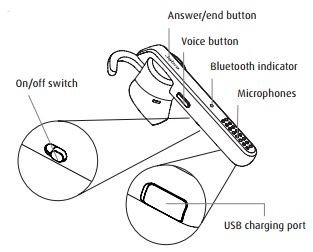 To enhance the Stealth UC experience, download the free Jabra app. More information about the apps can be found here: Jabra Apps.
To enhance the Stealth UC experience, download the free Jabra app. More information about the apps can be found here: Jabra Apps.
Jabra Assist helps you pair the headset with your device of choice without hassle, the battery meter warns you when you need to recharge your device, and when you need help using your headset and in-car speakerphone you can check the animated user guidelines in the app.
 The Stealth headset has been available for about a year; the addition of the USB dongle has made the headset feasible for the UC market. Those who work with their PC and smartphone will enjoy the ability to use either device with this headset. Available in both UC and Microsoft Lync-optimized versions, the Stealth UC is compatible with any major softphone on the market.
The Stealth headset has been available for about a year; the addition of the USB dongle has made the headset feasible for the UC market. Those who work with their PC and smartphone will enjoy the ability to use either device with this headset. Available in both UC and Microsoft Lync-optimized versions, the Stealth UC is compatible with any major softphone on the market. A microPOWER battery (typically found in hearing aids) makes this the lightest-weight Bluetooth headset on the market – a mere 0.28 ounce! The small design provides a comfortable in-ear fit for wearing in either the left or right ear. To customize the fit, two sets (3 red and 3 black) of comfort ear gels of various sizes are included (see image). Users who prefer an ear hook wearing style have 2 different sizes of ear hook to choose from, which are also included in the box. The Stealth will stay in the ear, so an ear hook is not necessary.
A microPOWER battery (typically found in hearing aids) makes this the lightest-weight Bluetooth headset on the market – a mere 0.28 ounce! The small design provides a comfortable in-ear fit for wearing in either the left or right ear. To customize the fit, two sets (3 red and 3 black) of comfort ear gels of various sizes are included (see image). Users who prefer an ear hook wearing style have 2 different sizes of ear hook to choose from, which are also included in the box. The Stealth will stay in the ear, so an ear hook is not necessary. Wearers get talk time of up to 6 hours; to a fully charge the headset takes about two hours. A micro USB to USB charge cord and car charger are included in the box. A wall charger is available as an accessory purchase; however, most standard mini USB to USB charge cords will charge the headset (the exception is the iPhone 5 and 6 power cords). Talk time is stated each time you turn the headset on, so there are no surprises when you’re in the middle of a call, the battery dies, and your calls gets dropped!
Other features:
- Dedicated voice control button to communicate with Siri or Google Now (device dependent).
- Noise Blackout technology with dual mics for noise-cancelling.
- HD Voice enhances sound quality.
- NFC connection (if available on your device)
- Intelligent volume control automatically adjusts the volume you hear in your speaker.
- Dedicated Apple hardware built-in enables the “Made for Apple iOS” certificate.
- Bluetooth indicator light flashes blue for Bluetooth pairing; green when turning “on” and red when turning “off.”
- Voice commands.
MSRP for the Jabra Stealth UC and Stealth MS is $150.00.
 To enhance the Stealth UC experience, download the free Jabra app. More information about the apps can be found here: Jabra Apps.
To enhance the Stealth UC experience, download the free Jabra app. More information about the apps can be found here: Jabra Apps.Jabra Assist
Link to Jabra AssistJabra Assist helps you pair the headset with your device of choice without hassle, the battery meter warns you when you need to recharge your device, and when you need help using your headset and in-car speakerphone you can check the animated user guidelines in the app.
Driving User Adoption of Microsoft Lync Enterprise Voice
We recently co-hosted a webinar with Unify Square and Jabra titled, “Driving Successful User Adoption of Microsoft Lync Enterprise Voice.” An all-star cast, including Khai Tran from Jabra, highlighted the challenges of Lync deployments, some ways to smooth the transition, and the importance of choosing high quality audio devices that best fit the environment and users.
The #1 reason why Lync adoptions fail? Unify Square says that the fear of change is the biggest determinant of failure. At its core, Microsoft Lync changes the way people work. The success of Lync deployments depend on end users and each end user adapts at their own rate. An organization can’t leave them to their own “devices” – the key to user adoption is to encourage staff to embrace and participate in the changes. In other words, you need to meet users where they live.
The good news: when you manage the change (by being proactive), you can better guide the implementation and adoption, culminating in a positive outcome.
Unify Square staff shared steps for successful adoption:
1. Determine the business outcomes desired and then SHARE those goals with everyone.
2. Segment users into common groups and find out about common adoption challenges, for example, what concerns them about not having a desk phone?
3. Create training materials for end users that cover the basics and how to get assistance; a centralized web site, feedback program and real-time support lay the groundwork for success.
4. Host “Device Demo Days” where users can try out sample devices to determine preference (one ear vs. two ear headsets; over the head vs. behind the neck wearing style, etc.).
“Devices make experiences”
Of course, a key element to successful adoption is what’s known as “The Last Three Feet” in telecommunications: the devices (headsets, speakerphones, and more) that are used. The device must be user friendly – comfortable, reliable and easy-to-use. The device must also be of high quality: incorporating hearing protection and speech analytics technologies, superior materials, and durable construction are just a few of the necessities. If a low end, poor quality device is chosen, the overall Lync deployment is in jeopardy. The quality of the system is judged by the quality of the voice experience.
Jabra has a variety of devices optimized for Microsoft Lync that are plug-and-play. As a Microsoft Gold Communications Partner, Jabra devices integrate into current and new generations of Microsoft Lync solutions, delivering the ultimate voice collaboration experience. See the entire portfolio of Jabra Lync Optimized audio devices here: Jabra Lync Device Portfolio.
Because a Lync Voice solution is only as good as the audio end-point used, Jabra has a Discovery Offer of up to five free devices for companies who are rolling out Microsoft Lync or Microsoft Office 365. Read more about the Discovery Offer on the Jabra web site.
Are you interested in learning more about deploying Lync at your organization? Do you need a blueprint for successful adoption? Have you considered “The Last Three Feet?” We’re here to help – give us a call today!
The #1 reason why Lync adoptions fail? Unify Square says that the fear of change is the biggest determinant of failure. At its core, Microsoft Lync changes the way people work. The success of Lync deployments depend on end users and each end user adapts at their own rate. An organization can’t leave them to their own “devices” – the key to user adoption is to encourage staff to embrace and participate in the changes. In other words, you need to meet users where they live.
The good news: when you manage the change (by being proactive), you can better guide the implementation and adoption, culminating in a positive outcome.
Unify Square staff shared steps for successful adoption:
1. Determine the business outcomes desired and then SHARE those goals with everyone.
2. Segment users into common groups and find out about common adoption challenges, for example, what concerns them about not having a desk phone?
3. Create training materials for end users that cover the basics and how to get assistance; a centralized web site, feedback program and real-time support lay the groundwork for success.
4. Host “Device Demo Days” where users can try out sample devices to determine preference (one ear vs. two ear headsets; over the head vs. behind the neck wearing style, etc.).
“Devices make experiences”
Of course, a key element to successful adoption is what’s known as “The Last Three Feet” in telecommunications: the devices (headsets, speakerphones, and more) that are used. The device must be user friendly – comfortable, reliable and easy-to-use. The device must also be of high quality: incorporating hearing protection and speech analytics technologies, superior materials, and durable construction are just a few of the necessities. If a low end, poor quality device is chosen, the overall Lync deployment is in jeopardy. The quality of the system is judged by the quality of the voice experience.
Jabra has a variety of devices optimized for Microsoft Lync that are plug-and-play. As a Microsoft Gold Communications Partner, Jabra devices integrate into current and new generations of Microsoft Lync solutions, delivering the ultimate voice collaboration experience. See the entire portfolio of Jabra Lync Optimized audio devices here: Jabra Lync Device Portfolio.
Because a Lync Voice solution is only as good as the audio end-point used, Jabra has a Discovery Offer of up to five free devices for companies who are rolling out Microsoft Lync or Microsoft Office 365. Read more about the Discovery Offer on the Jabra web site.
Are you interested in learning more about deploying Lync at your organization? Do you need a blueprint for successful adoption? Have you considered “The Last Three Feet?” We’re here to help – give us a call today!

